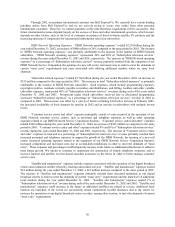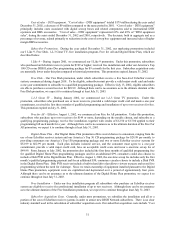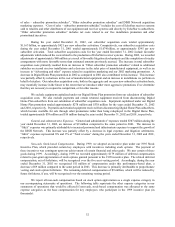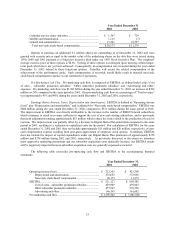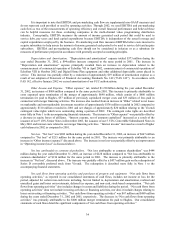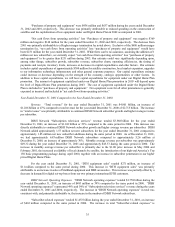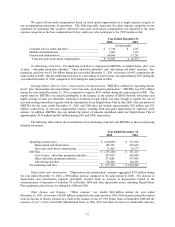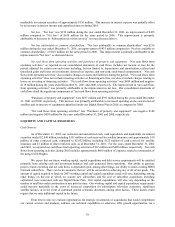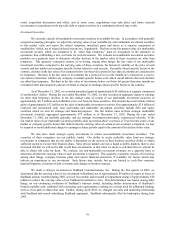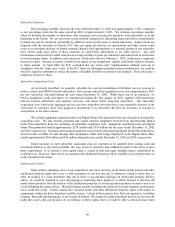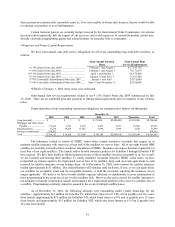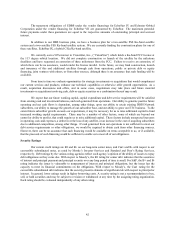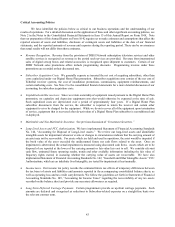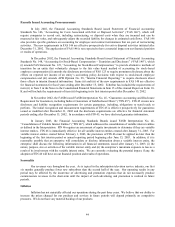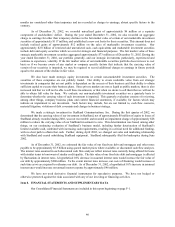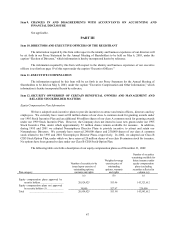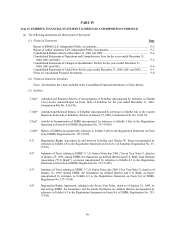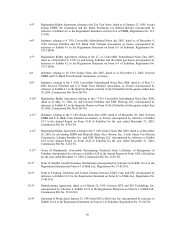Dish Network 2002 Annual Report Download - page 42
Download and view the complete annual report
Please find page 42 of the 2002 Dish Network annual report below. You can navigate through the pages in the report by either clicking on the pages listed below, or by using the keyword search tool below to find specific information within the annual report.40
Subscriber Turnover
Our percentage monthly churn for the year ended December 31, 2002 was approximately 1.59%, compared
to our percentage churn for the same period in 2001 of approximately 1.60%. We calculate percentage monthly
churn by dividing the number of subscribers who terminate service during the month by total subscribers as of the
beginning of the month. We are not aware of any uniform standards for calculating churn and believe presentations
of churn may not be calculated consistently by different entities in the same or similar businesses. Impacts from our
litigation with the networks in Florida, FCC rules governing the delivery of superstations and other factors could
cause us to terminate delivery of distant network channels and superstations to a material portion of our subscriber
base, which could cause many of those customers to cancel their subscription to our other services. Any such
terminations could result in a small reduction in average monthly revenue per subscriber and could result in an increase
in our percentage churn. In addition, price increases, which were effective February 1, 2003, could cause a temporary
increase in churn. Increases in piracy or theft of our signal, or our competitors’ signals, could cause churn to increase
in future periods. In April 2002, the FCC concluded that our “must carry” implementation methods were not in
compliance with the “must carry” rules. If the FCC finds our subsequent remedial actions unsatisfactory, we could be
forced by capacity constraints to reduce the number of markets in which we provide local channels. This could cause a
temporary increase in churn.
Subscriber Acquisition Costs
As previously described, we generally subsidize the cost and installation of EchoStar receiver systems in
order to attract new DISH Network subscribers. Our average subscriber acquisition costs were approximately $421
per new subscriber activation during the year ended December 31, 2002. While there can be no assurance, we
believe heightened credit procedures we implemented during the first quarter of 2002, together with promotions
tailored towards subscribers with multiple receivers, will attract better long-term subscribers. Our subscriber
acquisition costs, both in the aggregate and on a per new subscriber activation basis, may materially increase to the
extent that we introduce other more aggressive promotions if we determine that they are necessary to respond to
competition, or for other reasons.
We exclude equipment capitalized under our Digital Home Plan promotion from our calculation of subscriber
acquisition costs. We also exclude payments and certain returned equipment received from disconnecting Digital
Home Plan subscribers from our calculation of subscriber acquisition costs. Equipment capitalized under our Digital
Home Plan promotion totaled approximately $278 million and $338 million for the years ended December 31, 2002
and 2001, respectively. Payments and returned equipment received from disconnecting Digital Home Plan subscribers,
which became available for sale through other promotions rather than being redeployed in the Digital Home Plan,
totaled approximately $38 million and $16 million during the years ended December 31, 2002 and 2001, respectively.
Funds necessary to meet subscriber acquisition costs are expected to be satisfied from existing cash and
investment balances to the extent available. We may, however, decide to raise additional capital in the future to meet
these requirements. If we decide to raise capital today, a variety of debt and equity funding sources would likely be
available to us. However, there can be no assurance that additional financing will be available on acceptable terms, or
at all, if needed in the future.
Intellectual Property
Many entities, including some of our competitors, now have and may in the future obtain patents and other
intellectual property rights that cover or affect products or services directly or indirectly related to those that we
offer. In general, if a court determines that one or more of our products infringes on intellectual property held by
others, we would be required to cease developing or marketing those products, to obtain licenses to develop and
market those products from the holders of the intellectual property, or to redesign those products in such a way as to
avoid infringing the patent claims. Material damage awards, including the potential for triple damages under patent
laws, could also result. Various parties have asserted patent and other intellectual property rights with respect to
components within our direct broadcast satellite system. Certain of these parties have filed suit against us, including
Gemstar, Starsight and Superguide, as previously described. We cannot be certain that these persons do not own the
rights they claim, that our products do not infringe on these rights, that we would be able to obtain licenses from


